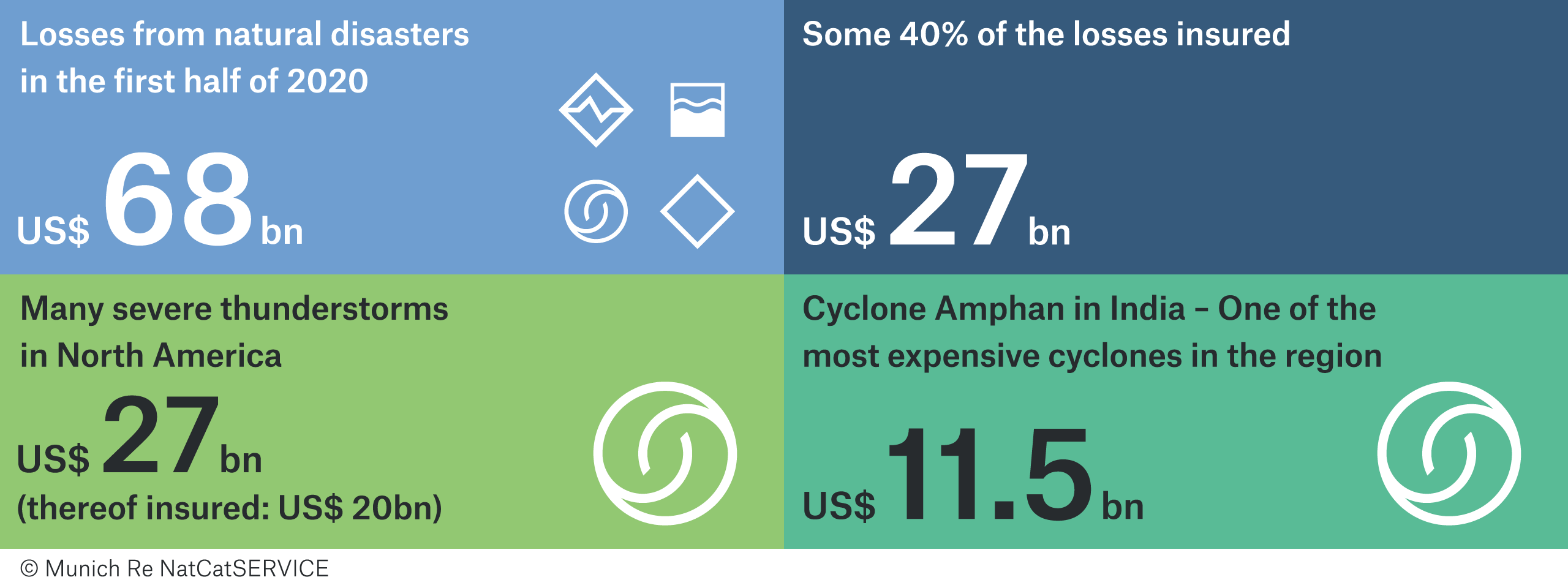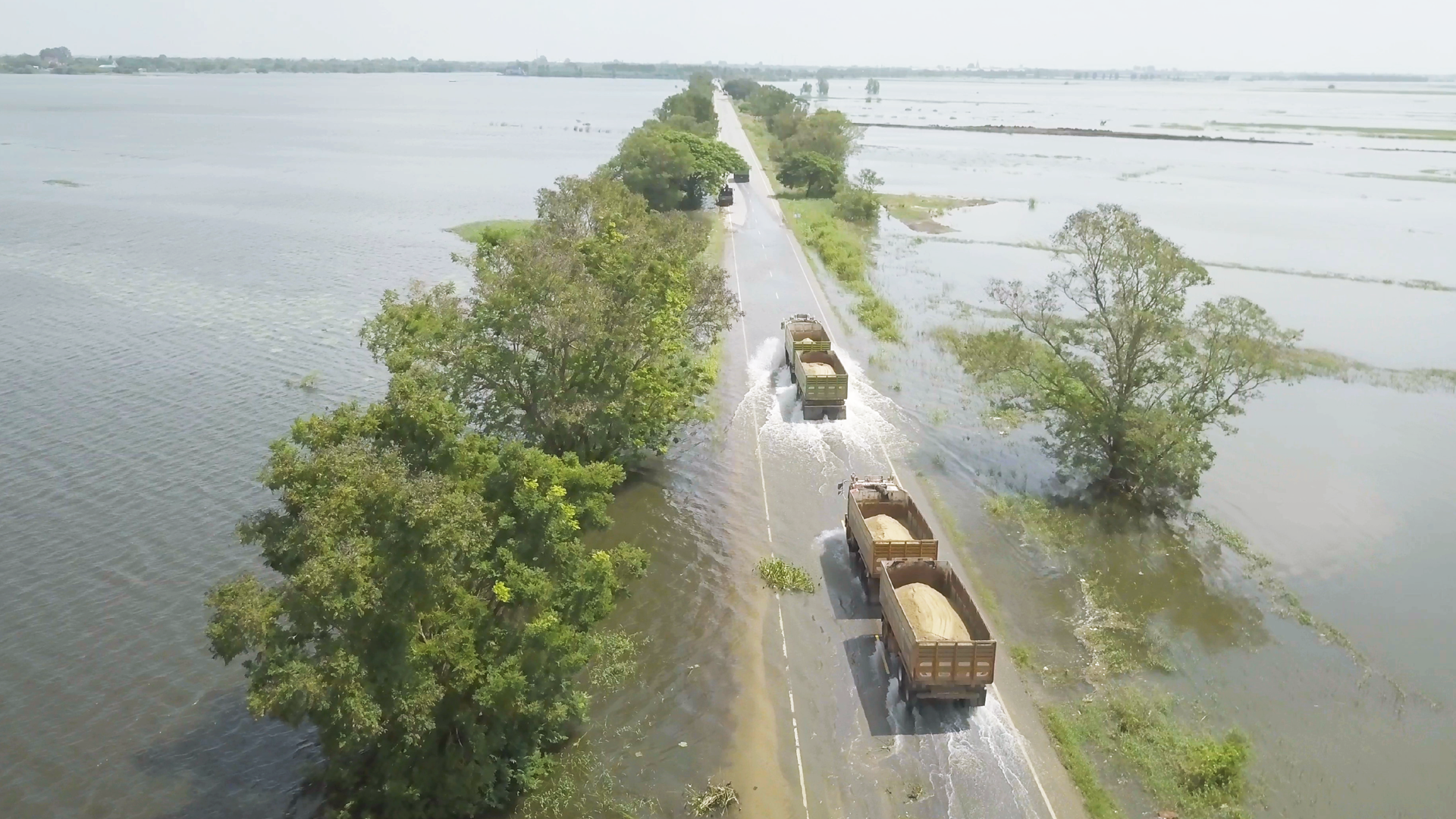Very high losses from thunderstorms – The natural disaster figures for the first half of 2020
2020/07/23
Reinsurance
properties.trackTitle
properties.trackSubtitle
- Very high losses from severe thunderstorms with tornadoes, flash floods and hail in North America: 8 events with billion-dollar insured losses
- Cyclone Amphan in India was the costliest natural disaster of the first half of 2020; only a small proportion of the losses were insured
- Climatological conditions will favour an active hurricane season in the North Atlantic and wildfires in California


The natural disaster statistics for the first half of 2020 point to two things in particular: One: severe thunderstorms in North America dominate the loss figures; this demonstrates the need to strengthen building resilience to mitigate losses. Two: this is especially relevant because climate change is likely to play a role in increasing the thunderstorm risk in North America in the long term. The world finally needs to take vigorous action to reduce greenhouse gas emissions in order to prevent losses and ensure we are not taken unawares by the consequences of climate change, as we were with the current coronavirus pandemic.
Overview of natural disaster figures for the first half of 2020
Up to the end of June, natural disasters produced overall losses of around US$ 68bn, a slightly lower figure than the 30-year average (US$ 74bn after adjustment for inflation). Insured losses, at around US$ 27bn, were higher than usual (US$ 20bn) due to the large proportion of weather disaster losses in North America.
North America accounted for 47% of overall losses and for 82% of insured losses, significantly more than the respective long-term averages (35% and 60%). In contrast, natural disasters in Europe and the Asia-Pacific region produced lower losses.
A total of 2,900 people lost their lives in natural disasters in the first half of the year, much lower than the average figures for both the last 30 years and the last 10 years.
Southeastern USA hit by series of severe tornadoes
One of the largest severe thunderstorm outbreaks in 2020 occurred over the Easter weekend, when a strong frontal system over the Southeastern United States spawned dozens of tornadic thunderstorms and produced hailstones the size of tennis balls. A total of 140 tornadoes in 10 states were recorded, of which 3 reached EF4 intensity, the second-highest rating, with winds up to 300 km/h (186 mph). Countless homes were completely destroyed, and cars and buses were tossed into the air.
The strongest tornado in Mississippi’s history was recorded during this outbreak. Its funnel was more than three and a half kilometres (2.25 miles) across at its widest point, and the twister stayed on the ground for almost 100 km (62 miles) before dissipating. Its path of destruction could be seen in satellite images, though fortunately the storm missed major population centers in the area. In total, the severe storms resulting from this outbreak caused overall losses of US$ 3.4bn, of which US$ 2.6bn was insured and 38 people lost their lives.
Another severe event occurred on 14 June in the city of Calgary in the Canadian Province of Alberta, when a hailstorm with stones also the size of tennis balls came crashing down as it passed over the city. Countless houses and cars were badly damaged, and many roads suffered flash flooding caused by torrential rainfall as the storm drains were blocked by hailstones. Some vehicles were almost completely submerged, and some drivers had to be rescued from the sudden raging waters around them. Overall losses came to some US$ 1.2bn, of which around 75% was insured. It was the highest loss from a thunderstorm in Canada’s history.
In total, severe thunderstorms in North America were responsible for US$ 27bn of overall losses and for US$ 20bn of insured losses in the first half of the year.
Ernst Rauch, Chief Climate and Geo Scientist at Munich Re, expressed his concern: “While we cannot attribute individual events to climate change, the trend in our data clearly shows that losses from severe thunderstorms, particularly in North America, are on the rise, largely as a result of population and exposure growth in suburban and exurban regions as well as increased property values and poor construction practices. A contribution of climate change is also seen likely because higher temperatures and greater humidity favour the development of weather patterns like these. Even in these times of global pandemic, we should not forget that climate change is also a risk with systemic elements.”
Super-cyclone Amphan and floods in China caused severe overall losses
The worst natural catastrophes occurred in Asia: In May, Cyclone Amphan caused extreme losses in India and Bangladesh. At times, Amphan was a so-called super cyclone – the highest category – with wind speeds of up to 260 km/h. When making landfall in West Bengal on the border with Bangladesh, the storm reached wind speeds of around 150 km/h. The high wind speeds, extreme precipitation and a metre-high storm surge caused extensive damage. Thousands of houses were destroyed, and millions of people were left without electricity. Some 135 people died and several million people were able to be evacuated. The evacuations were made all the more difficult by the corona pandemic, as fewer people were able to enter the shelters due to social distancing restrictions.
With total losses of around US$ 11.5bn, Amphan was one of the most expensive cyclones in the North Indian Ocean. The insured loss has not yet been determined, but is likely to account for a relatively small proportion of overall losses.
In China, heavy monsoon rainfall from June onwards led to severe river flooding of hundreds of rivers in many parts of the country. More than 100 people lost their lives. It is not yet possible to make a reliable estimate of the damage as the floods continued into July. According to initial estimates, however, the minimum total losses will be in the high single-digit billion range.
Winter storm Ciara (known as Sabine in Germany) was the costliest natural disaster in Europe. With winds of up to 200 km/h, it affected large parts of Europe in early February. Tens of thousands of people found themselves without electricity, and thousands of flights and major events, such as football matches, were cancelled. Although it was only a medium-strength winter storm, Ciara impacted a large swath of central Europe and produced a relatively high overall loss of US$ 1.8bn (€1.6bn), of which US$ 1.2bn (€1.1bn) was insured.
Record bushfires in Australia
Above-average hurricane season possible in the second half of the year
The naturally occurring climate cycle known as the El Niño-Southern Oscillation (ENSO) will likely be an influential factor in the North Atlantic hurricane activity in the second half of the year. In the main months of the hurricane season (August–October), “La Niña” conditions are forecast to develop, which can promote the development and intensification of tropical cyclones over the tropical Atlantic. Even the wildfire season in California, particularly in the northern section of the state, could be more extreme this year, as La Niña-type conditions typically create unusually dry conditions across the region in autumn, delaying the usual winter rains.
“Of course, here we are only talking about shifts in probabilities with regard to La Niña’s potential impacts this year,” says Mark Bove, Natural Catastrophe Solutions Manager at Munich Re America. “There is always the chance of a benign wildfire and/or hurricane season. But since background conditions indicate the potential for a more active wildfire season in California and elevated hurricane activity in the Atlantic, it is more important than ever to be well prepared to protect vulnerable populations, especially given the current pandemic situation.”
Further information
Munich Re is one of the world’s leading providers of reinsurance, primary insurance and insurance-related risk solutions. The group consists of the reinsurance and ERGO business segments, as well as the asset management company MEAG. Munich Re is globally active and operates in all lines of the insurance business. Since it was founded in 1880, Munich Re has been known for its unrivalled risk-related expertise and its sound financial position. It offers customers financial protection when faced with exceptional levels of damage – from the 1906 San Francisco earthquake through to the 2019 Pacific typhoon season. Munich Re possesses outstanding innovative strength, which enables it to also provide coverage for extraordinary risks such as rocket launches, renewable energies, cyberattacks, or pandemics. The company is playing a key role in driving forward the digital transformation of the insurance industry, and in doing so has further expanded its ability to assess risks and the range of services that it offers. Its tailor-made solutions and close proximity to its customers make Munich Re one of the world’s most sought-after risk partners for businesses, institutions, and private individuals.
Disclaimer
This media release contains forward-looking statements that are based on current assumptions and forecasts of the management of Munich Re. Known and unknown risks, uncertainties and other factors could lead to material differences between the forward-looking statements given here and the actual development, in particular the results, financial situation and performance of our Company. The Company assumes no liability to update these forward-looking statements or to make them conform to future events or developments.
/Ziegler_Frank.jpg)
/Faith_Thoms.jpg)

